Shaping Vancouver 2018: Conversation 1
The Complexity of Places: The Heather Street LandsMay 10, 2018
This session of Shaping Vancouver explores the framing of heritage, looking at the ways in which different definitions of heritage require different approaches. Moderator Bill Yuen first discussed the changing approach to heritage, beginning with the Burra Charter from 1979. This charter introduced a way to approach heritage beyond physical, material, buildings and historical materials, and has informed heritage practice today. The most integral aspect of new approaches to heritage is that places can be important and meaningful in a multitude of ways.

Moderator
Bill Yuen
- Executive Director of the Heritage Vancouver Society
Panelists
Lyana Patrick: member of the Stellat’en First Nation of the Carrier Nation in British Columbia, Acadian/Scottish
- Has worked in communications and education for over two decades; holds a Master’s degree in the Indigenous Governance program at the University of British Columbia and has worked at UBC for the past twelve years
- Worked as the Education Coordinator in the Division of Aboriginal People’s Health in the Faculty of Medicine and was the Research Manager for a Movember-funded project that focused on health promotion for Indigenous men in Vancouver’s Downtown Eastside
- Currently finishing doctoral studies in the School of Community and Regional Planning at UBC
Varouj Gumuchian: facilitator for the Riley Park South Cambie Visions Group
- The RPSC Visions Group works to disseminate the community vision document that discusses the social fabric of the Riley Park South Cambie area, including cultural, evironmental, historical, and community stabilizing concerns
- Has organized several charettes to share the accumulated knowledge of participants and integrate varying sensibilities in decision making
Julia Hulbert: Master’s student at SFU in Urban Studies writing a thesis on decolonizing municipal heritage programs
- Active member of the community serving the City of Vancouver’s Heritage Commission and as the Chair if the Kitsilano Thingery Board of Directors
- Has over a decade of experience working in the cultural sector in Vancouver and Victoria, and recently has started consulting in arts and culture planning
- Current Radius Fellow, a fellowship that provides professional development training for individuals working in systems change
The Heather Street Lands is a historic Musqueam Indian Band, Squamish Nation, and Tsleil-Waututh Nation area of hunting and gathering, as it was an area rich in resources and near a peninsula crossing. In 1911, it became a business site, and the Fairmont Academy, a private school, was opened in 1914. In 1919, the business closed, and the building became the Shaughnessy Military Hospital, where Jean Matheson, a renowned Canadian nurse, was the patron. In 1920, this building housed an RCMP headquarter until 2013. Afterwards, the MST Partnership and the Canada Lands Company entered into a relationship to own and redevelop the site. The City of Vancouver has also conducted surveys, dialogues, and communications to gather information on this site – regarding the building however, First Nations have voiced negative associations with the structure as it symbolizes a period when their customs and culture were oppressed and have asked for the removal of the building as an action of reconciliation.
The Burra Charter advocates for a values-centered approach to heritage – the Heather Street Lands is a site of many different values. It is crucial that we work out how these values can be conveyed on the site because in addition to historical value, there are also cultural, social, architectural, natural and economic values.
Panelists
Lyana Patrick – doctoral student in the School of Community and Regional Planning at UBC
Varouj Gumuchian – facilitator for the Riley Park South Cambie Visions Group
Julia Hulbert – Master’s student at SFU in Urban Studies writing a thesis on decolonizing municipal heritage programs
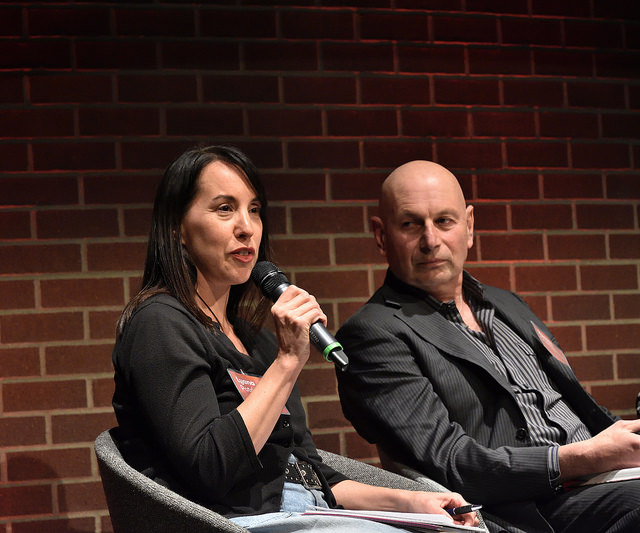
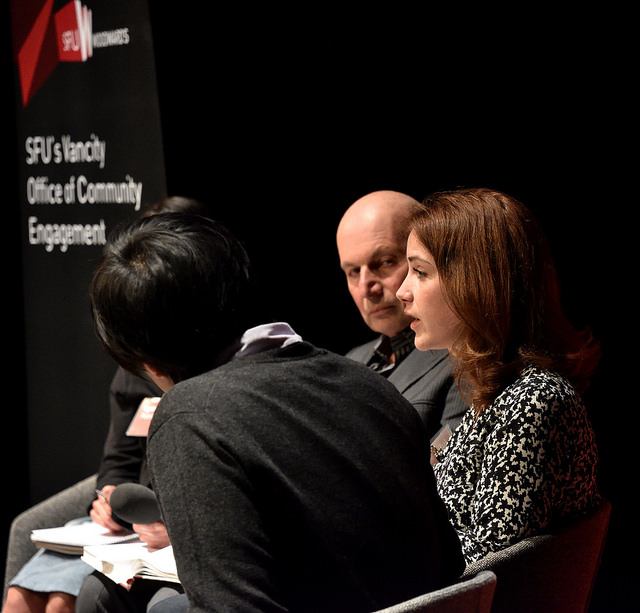
Indigenous planning: what is it? How is this relevant to the Heather Street Lands? (10:57)
Lyana Patrick opened by stating that she was speaking from her own experiences and the partnerships she has developed, and hoped to provide insight into how planning has evolved and is evolving. When she started in the planning program at UBC in 2011, she brought in a background in the BC context, which encompassed a complex and extensive history of planning involving culture, language, and land – land being especially complex, as many land treaties were not signed in BC. In 2010, there was a recognition that there was a huge gap in planning, as there was nothing comprehensive about indigenous knowledge – now, the indigenous stream in planning at UBC is unprecedented in Canada. The memorandum of understanding with the Musqueam is integral to this, demonstrating a cultural and institutional shift in planning.
Overall, this is a more long-term and comprehensive view of planning that involves the entire community and includes a broad scope of community needs – this is also an educative piece for students and expose them to the complexities of working with First Nations communities. In the urban planning environment, 50% of indigenous peoples live off reserve, and Vancouver is also on the territory of indigenous nations – how can we respond to the historic, cultural, linguistic, and intense diversity that the city brings?
How do we equip ourselves to work with the First Nations on planning projects? (18:01)
Julia Hulbert stated that coming from a settler background, this was a difficult process for her to engage with, and there were many personal barriers that stood in the way of meaningful engagement. When indigenous peoples are invited to speak, they speak about their relationship to the place – with the Heather Street Lands, this is an opportunity to speak about a relationship to place. We must ask: what is the significance of this site? How do we start constructing these values? How are they significant to us? The communities? She remarked that as stakeholders, all we can share are perspectives from ourselves.
Varouj Gumuchian stated that there is a sense of isolation and disconnect with the Heather Street Lands, especially with the projects along the Cambie Corridor (20:54). The differences that arise with these projects can be solved with open discussions, which becomes a real, ongoing, and incomplete learning experience.
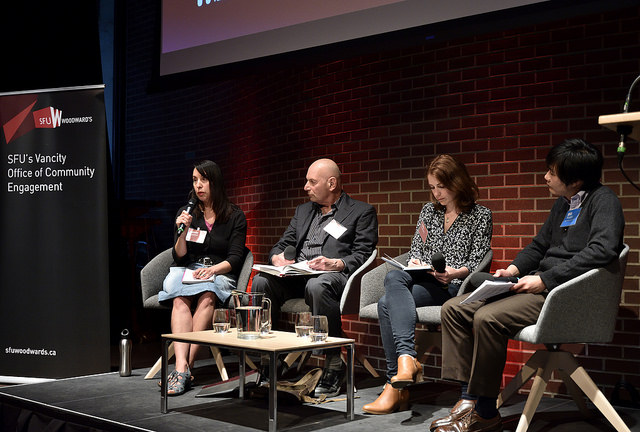
Are ongoing discussions with stakeholders becoming a new tool? Is it too late to be talking about this, since the project has already been proposed? (23:03)
Varouj stated that sensitivities and complexities are evident, thus the process needs to be more democratic. Julia referenced the Burra Charter, stating that earlier, ‘heritage’ referred to sites of architecture or historical places. The shift to a values-based approach materialized only in the early 2000s, so the people-centered focus on place is still tied to material assets, but work is being done by consulting with stakeholders to develop a better understanding of cultural significance. Julia also noted that the Heather Street Lands project is interesting because it is a reflection of the nuances to a place; the values we talk about are tied to material aspects such as the architecutral merit of Fairmont Building, however the cultural significance goes beyond development of the site.
The removal of a building causes conflict; should we have conflict resolution mechanisms in place in planning? (26:51)
Lyana responded that it was important to open up spaces for conflict and work through and across differences – she mentioned Aftab Erfan from the UBC School of Community and Regional Planning who works in conflict resolution, and the need to bring in people like Aftab who are able to help navigate these issues. Lyana also spoke about therapeutic planning, which is necessary when there is limited space for people to articulate their connections to places. Therapeutic planning is about the idea of ensuring that stories can be told and shared – there is a place and a need to allow intense differences to be brought into the open, especially with topics such as the removal of a building, to avoid reopening or creating trauma and creating space for healing. Lyana also mentioned the Ktunaxa community and how they reclaimed a former residential school by transforming it into a resort as an example of the role of conflict in community development.
Varouj spoke about outcomes, with options of including collaboration and treating the site as a realm of memory (32:10). He mentioned that there was optimism around the Cambie corridor and the community is looking for conversation and values-based heritage – the Heather Streets Lands could become a space for social interaction or serve as a token of reconciliation. Julia mentioned that there is also the aspect of undoing colonialization and mentioned the colonial structure of designation of the Fairmont Building on the Heritage A registry. She stated that Vancouver’s policies support the preservation of this building, but there are values that are just as important to consider, such as the cultural weight that comes with the request to remove this building. Julia also mentioned that systems may place certain values over others, and this is an issue that also needs to be addressed.
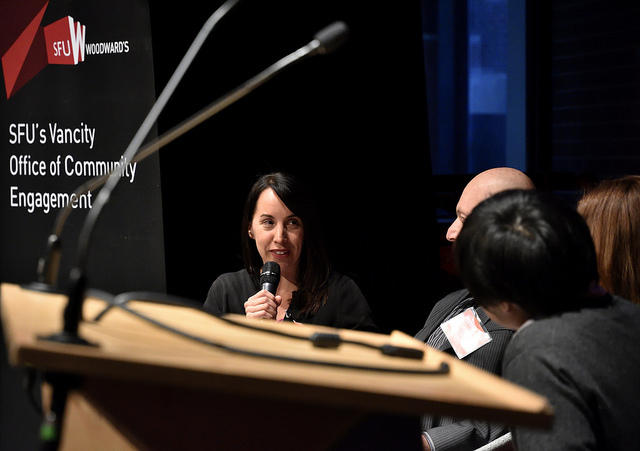
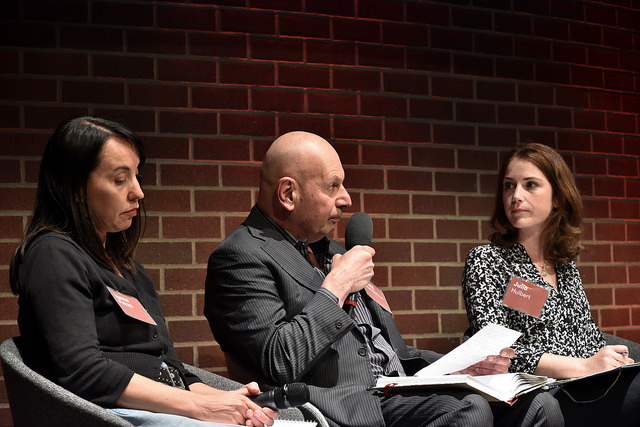
What do you think about values-based heritage? (37:17)
Lyana said that in indigenous planning, nations are not often stakeholders, though the city has built up significant resources to build nation-to-nation relationships. Heritage designation is a particularly value-laden aspect of planning, and to decolonize this aspect, it should be up to the nations to decide how they will approach and engage with this process. Lyana noted that there has always been a divide between ‘the city’ and ‘the reserve’ and there is a sense that indigenous values do not belong in the city. However, contact zones, where cultures come together in often-asymmetrical power relations, can have spaces were the ‘other people’ assert their control.
Julia responded that she has noticed an emergence of emphasis on intangible cultural heritage with a movement towards civic policies that allow for the safeguarding of intangible cultural heritage (42:43). In Edmonton, there is a heritage program that involves the creation of a list of intangible cultural assets, and this could be possible in Vancouver as well.
Act of reconciliation: MST Partners asked that the building be removed as an act of reconciliation – does it end there? Is the site taking on new significance? (44:21)
Varouj responded that there may be a sense of loss, removal and disconnect – a grieving process for some people, such as RCMP veterans, who may have strong attachments to the building – however, this is an issue that is still unresolved. Julia said that this issue requires a new approach for all parties, and people need to understand what their relationships to reconciliation are – moreover, there needs to be space for conversations to continue.
Lyana stated that there needed to be a profound rethinking of relationships between indigenous and non-indigenous peoples (47:51). To begin understanding reconciliation, people need to educate themselves, know stories, engage in conversations, and know the history of a place.

On the topic of conversations: in heritage, we often look at other examples to inform decisions. The Berlin Memorial of the Holocaust was a very messy process that is quite well known – do you think we need more conversation? Do we undervalue it? (50:48)
Julia responded that we are an outcome-driven society, and the challenge of reconciliation lies in a focus on the process instead of the outcome – conversation is necessary for this. Varouj added that there is a mystification of what is at play, and there may be fears of sharing one’s connection to a place. Lyana said that we need to be creative and bold in our approaches and create new innovation spaces and ways to hold conversations, such as engaging with tension and conflict in a supportive way. Varouj also stated that initially, the Riley Park South Cambie Visions Group supported retention of the building, but this perspective was reconsidered after consultation with the MST.
Questions from the audience
Could you speak to the way how the planning process has been in itself, colonial?
Varouj answered that the study of planning has its origins in a euro-centric approach.Julia responded that she was impressed with the stakeholder event that was held, as a well-facilitated event shows an attempt toward an understanding of decolonization. Lyana stated that community engagement work means being responsive to the community.
Speaking to colonialism and the erasure of indigenous cultures: is indigenous planning a way to reclaim their old value systems, or to navigate a modern one?
Lyana answered that there is an enduring threat to cultural continuity, such as disruptions by residential school and the Indian Act. Indigenous communities speak about resurgence; they have speakers, ceremonies, songs, and such – indigenous planning is a way to equip communities to have strength in their cultures and the settler’s culture, and not value one over the other.
From a purely practical perspective: where can a building go that doesn’t continue to stand as a beacon of colonialism? Where can you relocate it so that it loses negative connotations? What will the building be if it is removed?
Julia responded that the city is pursuing solutions to relocating the site, and the city recently supported relocation in its policy for redevelopment. Varouj stated that the CLC-MST partnership has clauses for removal, though this is still a critical point. Julia also questioned which values were given more prominence to, and whether architectural value was more regarded than cultural value. Bill noted that some values that are significant are not manifesting in the building in its current site, such as the nursing and female leadership histories associated with the site – relocating the building could present an opportunity to highlight different values. Bill also asked how many people knew the building was a Class A building, and why it was designated as such – perhaps heritage needs to do more to help people learn why spaces.
What’s the point of relocating the building? As well, as a Vancouver culture, we are suffering from a new form of colonization, and we are reliving a form of colonization. People need to come to a commonality and look backwards into the future. What happens if the building is gone? What happens to the rest of the area?
Lyana responded by speaking about the presence of statues of controversial people – what should happen to these memorials? Should they be taken down, or remain as teaching tools? Our conversations point to such discussions, but there are also opportunities to include more interpretations.
Where does the development of the HSL fit into the arc of reconciliation? Especially since Vancouver itself is on unceded territory – if they tear down this building, what is next?
Varouj stated that there needs to be a response from the public and an effort to understand reconciliation. Julia added that the building itself is controversial because this site was a site of trauma, which is one of the reasons why it was not a strongly considered option for it to be retained. Bill said that the inability to answer questions shouldn’t impede a decision on whether a structure should be removed. There are places where trauma has spurred removal of objects, or where sites of conscience have been kept – it depends on the quality of dialogue that can be had.
We all know about the atrocities felt by the First Nations; for the Fairmont Building, do two wrongs make a right? If they knocked down the building, would this address the trauma?
Julia asked whether it was wrong to knock down the building – under whose cultural values is this negative? This comes down to using a values-based approach and engaging with a multiplicity of values. Bill added that a values-based approach is considered progressive; in the Historic England conservation principles, policies and guidance document, heritage is viewed as community and social benefit, which brings more questions about what is wrong and what is right.
The burden of reconciliation has largely been placed on indigenous peoples – what do you think are proactive steps that settlers and those who have profited of the system can create a safer environment for FN to feel safe and supported to talk about their experiences?
Lyana stated that there is an educative component, such as cultural competencies training, that is crucial. People need to learn about indigenous history and colonial history – this is the first step.
We acknowledge the financial assistance of the Province of British Columbia. Thank you to SFU’s Vancity Office of Community Engagement for co-presenting the series.
All photo credits go to roaming-the-planet.